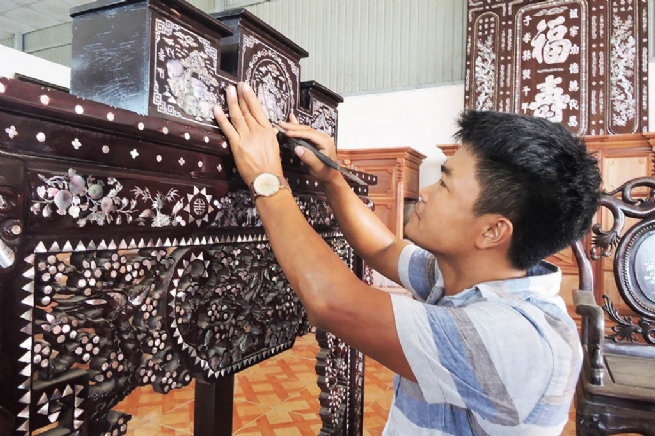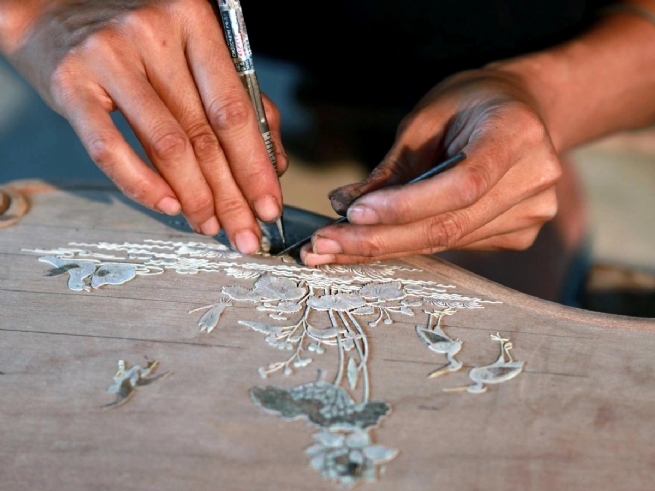The mother-of-pearl inlay craft village in Chuyen My commune, Hanoi, is expected to become a highlight of the city’s global outreach, as it has been proposed for membership in the World Crafts Council’s Creative Craft Cities Network. This represents both an opportunity to affirm the value of traditional craftsmanship and a test of the village’s sustainable development strategy in the digital era.

Chuyen My commune’s products are increasingly diverse in design and style, meeting domestic demand and expanding into international markets
The inlay and lacquer-ware craft in Chuyen My has a long history involving hundreds of households and dozens of artisan masters recognized at the city and national level. The proposal to join the global Creative Craft Cities Network offers local cultural heritage recognition and the chance to advance economic growth, tourism, and international promotion of village-craft products.
A 1,000-year-old craft village
Artisan Nguyen Dac Luyen shared that, according to ancient records, the mother-of-pearl inlay craft of Chuyen My dates back to the 11th century. Over generations, it has become a source of local pride, honoring skilled craftsmanship and reflecting intelligence, patience, and the Vietnamese spirit. Throughout history, countless artisans in Chuyen My have carefully sawed, polished, and inlaid each piece of shell or mother-of-pearl to create artistic works of great value, from altar boards, couplets, and cabinets to decorative items and inlaid paintings that embody the national soul. One notable figure was Nguyen Van Phu of Chuon Ngo village, who was summoned to the royal court in Hue and granted the ninth-rank official title.
From the 1970s onward, artisans such as Nguyen Van To, Tran Ba Chuyen, and Tran Ba Dinh carried on the tradition, creating many acclaimed inlay works. Among them, the group led by Nguyen Van To crafted more than 100 badges of President Ho Chi Minh for an important national political event. These artisans also portrayed President Ho Chi Minh, General Vo Nguyen Giap, Cuban leader Fidel Castro, and many world figures in shimmering mother-of-pearl and shell.

Many people think inlay work is simple, just carving, shaping, grinding, and assembling according to a pattern, but it is in fact a demanding art form that requires precision, patience, and exceptional skill. One of the most crucial stages in mother-of-pearl inlay is shell setting, which includes three steps: filing, chiseling, and trimming. These steps must be perfectly coordinated; if any one is poorly done, the artwork cannot be completed. During the process, artisans must manually grind the shell, soak it in liquor, heat-treat it, split the edges, choose the right chiseling craftsman, and carefully select full shell pieces for each panel. After the inlay is set, the wooden panels are refined, polished, and detailed to their final form. Thanks to the lifelike lines and expressive detailing, Chuyen My’s mother-of-pearl inlay has been admired for centuries. For generations, the craft has been passed from father to son, and thousands of artisans in Chuyen My have produced countless inlay artworks. Today, continuing their ancestors’ legacy, many skilled craftsmen still dedicate themselves wholeheartedly to this traditional art.
In the past, Chuyen My artisans mainly produced altar-boards and couplets for communal houses or temples, decorated panels on chests and cabinets, or created wall-hangings based on folk tales. Today those artisans also produce large-scale inlay artworks or portraits of national figures, military leaders, spiritual animals, flowers, plants and landscapes. As a result, the product range of Chuyen My village has grown increasingly diverse in design and style, meeting domestic demand and expanding into international markets across Europe and Asia.

Creativity for global integration
According to Nguyen Thi Thuy Huong, Vice Chairwoman of the Chuyen My Commune People’s Committee, the mother-of-pearl inlay and lacquer craft village has fulfilled nine criteria required to join the World Crafts Council’s Creative Craft Cities Network.
“We have met eight criteria and are now concentrating on completing the ninth, which involves creating new and innovative product designs. This is the key requirement for Chuyen My to be officially recognized. The application has been submitted to the World Crafts Council, and the evaluation is expected to take place in mid-November 2025,” Huong said.
To meet this requirement, Chuyen My artisans and inlay craftsmen are collaborating to create compact and distinctive products suitable as gifts and souvenirs for visitors. More than 100 new product designs have been completed, including inlaid pen boxes, ballpoint pens, vases, trays, photo frames, and mini mother-of-pearl paintings that preserve traditional features while appealing to modern markets.
Nguyen Dinh Hoa, Deputy Director of the Hanoi Department of Agriculture and Environment, emphasized that Chuyen My’s candidacy for the World Crafts Council’s Creative Craft Cities Network is not only a local honor but also part of Hanoi’s long-term strategy to preserve and promote traditional craft values.
“Chuyen My brings together all essential elements including heritage, people, technique, creativity, and integration. It has strong potential to develop craft-based experiential tourism and local culture. However, the locality needs to focus on completing the craft ecosystem, supporting young artisans, improving production conditions, and enhancing global brand promotion,” he said.
The story of Chuyen My is not only about one craft village but also reflects the vitality of Vietnamese culture, where tradition and modernity blend, and where artisans’ hands preserve the national soul while reaching out to the world.
From the shimmering light of seashells and mother-of-pearl emerges a lasting faith: the millennia-old essence of Chuyen My’s inlay and lacquer craft is being renewed each day through the creativity and aspiration for global integration of its gifted artisans.
By Bao Dan, Vietnam Business Forum
| This special section is supported by Hanoi Coordination Office of the New Rural Development Program |